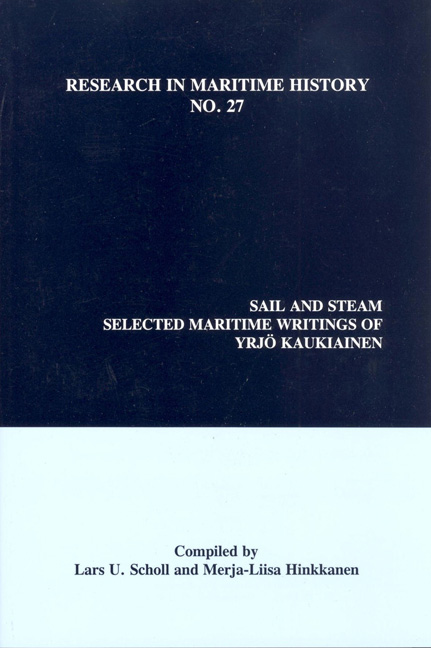Book contents
- Frontmatter
- Frontispiece
- Table of Contents
- Acknowledgements
- “Yrjö Kaukiainen: A Tribute on the Occasion of his Forthcoming Retirement as Professor of Maritime History at the University of Helsinki”
- “Yrjö Kaukiainen: A Man of the Sea”
- “Yrjö Kaukiainen and the Development of Maritime Economic History”
- “Finnish Sailors, 1750-1870”
- “Finnish and International Maritime Labour in the Age of Sail: Was There a Market?”
- “Five Years before the Mast: Observations on the Conditions of Maritime Labour in Finland and Elsewhere”
- “The Maritime Labour Market: Skill and Experience as Factors of Demand and Supply”
- “Owners and Masters: Management and Managerial Skills in the Finnish Ocean-Going Merchant Fleet, c. 1840-1880”
- “From Low-Cost to High-Cost Shipping: Finnish Maritime Labour Costs after the Second World War”
- “The Modernization of Finnish Coastal Shipping and Railway Competition c. 1830-1913”
- “British Timber Imports and Finnish Shipping 1860-1910”
- “Baltic Timber-Trade under Sail: An Example of the Persistence of Old Techniques”
- “Coal and Canvas: Aspects of the Competition between Steam and Sail, c. 1870-1914”
- “Dutch Shipping and the Swedish Navigation Act (1724). A Case Study”
- “Seamen Ashore: Port Visits of Late Nineteenth-Century Finnish Sailors”
- “Wreck-plundering by East Finnish Coastal People - Criminal Tradition or Popular Culture?”
- “From Days and Knots to Pounds and Dollars: Some Problems in the Study of the Economics of Late Nineteenth Century Merchant Shipping”
- “Tons and Tonnages: Ship Measurement and Shipping Statistics, c. 1870-1980”
- “International Freight Markets in the 1830s and 1840s: The Experience of a Major Finnish Shipowner”
- “Shrinking the World: Improvements in the Speed of Information Transmission, c. 1820-1870”
- “Yrjö Kaukiainen: A Maritime Bibliography”
“Dutch Shipping and the Swedish Navigation Act (1724). A Case Study”
- Frontmatter
- Frontispiece
- Table of Contents
- Acknowledgements
- “Yrjö Kaukiainen: A Tribute on the Occasion of his Forthcoming Retirement as Professor of Maritime History at the University of Helsinki”
- “Yrjö Kaukiainen: A Man of the Sea”
- “Yrjö Kaukiainen and the Development of Maritime Economic History”
- “Finnish Sailors, 1750-1870”
- “Finnish and International Maritime Labour in the Age of Sail: Was There a Market?”
- “Five Years before the Mast: Observations on the Conditions of Maritime Labour in Finland and Elsewhere”
- “The Maritime Labour Market: Skill and Experience as Factors of Demand and Supply”
- “Owners and Masters: Management and Managerial Skills in the Finnish Ocean-Going Merchant Fleet, c. 1840-1880”
- “From Low-Cost to High-Cost Shipping: Finnish Maritime Labour Costs after the Second World War”
- “The Modernization of Finnish Coastal Shipping and Railway Competition c. 1830-1913”
- “British Timber Imports and Finnish Shipping 1860-1910”
- “Baltic Timber-Trade under Sail: An Example of the Persistence of Old Techniques”
- “Coal and Canvas: Aspects of the Competition between Steam and Sail, c. 1870-1914”
- “Dutch Shipping and the Swedish Navigation Act (1724). A Case Study”
- “Seamen Ashore: Port Visits of Late Nineteenth-Century Finnish Sailors”
- “Wreck-plundering by East Finnish Coastal People - Criminal Tradition or Popular Culture?”
- “From Days and Knots to Pounds and Dollars: Some Problems in the Study of the Economics of Late Nineteenth Century Merchant Shipping”
- “Tons and Tonnages: Ship Measurement and Shipping Statistics, c. 1870-1980”
- “International Freight Markets in the 1830s and 1840s: The Experience of a Major Finnish Shipowner”
- “Shrinking the World: Improvements in the Speed of Information Transmission, c. 1820-1870”
- “Yrjö Kaukiainen: A Maritime Bibliography”
Summary
During the first half of the seventeenth century, between fifty and seventy percent of ships registered in the Sound Toll accounts were Dutch. Not surprisingly, such a dominance of “outsiders,” in the shipping between the Baltic and Western Europe provoked different attempts by various Baltic powers to limit the Dutch economic influence. In particular, this concerned Sweden which was rising to a major military power and gaining control over the best part of Baltic coastal lands. From the 1610s onwards, a customs tariffs system favouring domestic vessels was created and later the Swedish government concentrated the trade in the most important export and import commodities (iron, copper, tar, salt, tobacco) to monopoly companies which were controlled by major Stockholm merchant houses. It seems that the Swedish economic policy was moderately successful: at least the number of Dutch ships carrying Swedish exports diminished and the merchant tonnage of the Swedish capital increased. However, this coin may have had another side: it seems probable that, in the 1690s, a substantial share of Stockholm's merchant fleet was in fact owned by Dutchmen.
However, it was only after the Great Nordic War that Sweden brought its trading policy to a logical conclusion by decreeing a full-fledged mercantilist Navigation Act (1724). Precisely as its British predecessor had done, it only allowed foreign ships to import products from their respective countries, or from their colonies. Even this act was primarily aimed against the Dutch who traditionally imported both salt and colonial goods to many Swedish ports, in particular to Finland. After the war, their position was indeed stronger than before. This depended not only on the fact that the Finnish ports had lost most of their ships, but also on the weakening influence of the Swedish capital over the eastern part of the realm with the discontinuation of the salt and tar companies. This is also clearly seen in the Sound Toll accounts: between 1722 and 1727, eighty-two percent of all ships sailing westward and loaded in Finland (a total of 275 vessels) were Dutch and fourteen percent English.
The war had actually increased Dutch interests in the eastern parts of Finland. Already in the 1680s, modern water-wheel sawmills were built at the mouth of the River Narva (on the border between Ingria and Estonia).
- Type
- Chapter
- Information
- Sail and SteamSelected Maritime Writings of Yrjö Kaukiainen, pp. 129 - 140Publisher: Liverpool University PressPrint publication year: 2004



